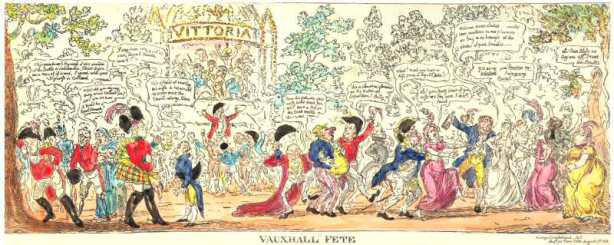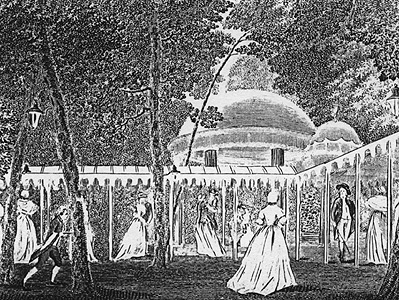Vauxhall Gardens: A History
David Coke & Alan Borg
The Vauxhall Pleasure Gardens is one of the places I’d love to slip back in time to visit, just to catch a glimpse of what it was like. After recently splurging to buy this lovely coffee-table book, I thought it might make a wonderful subject for a new blog series. But do buy the book too, if you can!
Grand Military Fetes and Displays
The first record of a military fete was on 30 May 1786, the day after the Jubilee, when transparencies of British men-of-war by the marine painter John Thomas Serres (1759-1825) were presented with other decorations, including a representation of the British lion trampling the Spanish flag. The newly formed Duke of York’s Band played military airs and was to perform regularly in the gardens until 1816. This period saw an increasing presence of soldiers and military bands, theoretically in response to the threat of invasion from France, but more directly in an attempt to rival the jingoistic displays to be seen at Astley’s. In 1787 the Cascade, the most famous of Vauxhall attractions in the eighteenth century, included marching soldiers. These military displays gradually expanded and needed more space, so from 1816 the Cascade site was used by Madame Saqui’s rope-dancing troupe.
Eventually, grand military fetes to celebrate actual events involved firework displays.
On 11 June 1810, Mizra Abul Hassan Khan wrote about his visit to the Gardens for the Grand Oriental Fete in honour of the Persian Ambassador:
The avenues were lighted by rows of tall candelabra and by lanterns hung from trees. In one place there were fireworks: when they did not rise high enough, everyone laughed and said ‘Shocking!’ The fireworks ended with the name of the Qibleh of the Universe written in Persian letters! Everyone appreciated this display and clapped their hands together. From there we went to a large covered place, beautifully lighted and decorated, like a theatre in the city. It was built to accommodate 5000 people in case of rain. After the fireworks, some people sat down to eat; later they danced.
American Samuel Morse, inventor of the Morse code, visiting on 17 September 1811:
A few evenings since I visited the celebrated Vauxhall Gardens, of which you have doubtless often heard. I must say they far exceeded my expectations; I never before had an idea of such splendor. The moment I went in I was almost struck blind with the blaze of light proceeding from thousands of lamps and those of every color. […] All is gayety throughout the gardens; every one is in motion, and care, that bane of human happiness, for a time seems to have lost her dominion over the human heart. Had the Eastern sage, who was in search of the land of happiness, at this moment been introduced into Vauxhall, I think his ost exalted conceptions of happiness would have been surpassed, and he would rest contented in having at last found the object of his wishes. […] The music and this course of dancing continue till about four o’clock in the morning, when the lights are extinguished and the company disperses. On this evening, which was by now means considered as a full night, the company consisted of perhaps three thousand persons.

George Cruikshank, Vauxhall Fete, engraving, 1813 (British Museum, London., 1862.1217.309). This satirical print shows many of the leading figures who attended the Grand Festival in honor of the Battle of Vittoria. On the left the Duke of York vomits against a tree; other notables include the Duke of Sussex in Highland uniform, the Duke of Clarence dressed as an Admiral, the Lord Mayor of London and Lord Castlereigh. On the far right a fat lady exclaims ‘They’re all drunk, the Brutes.’
Grand Festival of the Battle of Vittoria
On 20 July 1813, a Grand Festival of the Battle of Vittoria was held in honor of the then Marquess Wellesley, who attended. “The festival was ‘perhaps the most superb and costly entertainment ever given in England’ and such was its popularity that ‘the limited number’ of tickets ‘was exceeded and, in consequence, from ten to fifteen pounds was offered for a ticket’”. Byron noted:
There is to be a thing on Tuesday ycleped a national fete. The Regent and *** are to be there, and everybody else, who has shillings enough for what was once a guinea. Vauxhall is the scene—there are six tickets issued for the modest women, and it is supposed that there will be three to spare. The passports for the lax are beyond my arithmetic.
At a dinner for twelve hundred people in the Rotunda, the VIPs sat at a crescent-shaped, raised table. There was also
a row of crimson steps covered with massive pieces of ornamental gold and silver plate, with the bust of the Lord Wellington on the summit. At the foot, and leaning against a silver vase of exquisite workmanship, was the Marshal’s staff taken in the battle. Two trumpeters in their state liveries and with silver trumpets, stood forward from the pile, and between them a grenadier of the Guards held the standard of the 100th French regiment of the line.
Neither George III nor the Prince of Wales attended (in spite of Byron’s expectation), but otherwise, the list of attendees was quite impressive. Wellesley arrived late for the dinner and found his seat of honor occupied, but presumably that was quickly dealt with. The ladies joined the party at 9 p.m., and at 11 p.m., the Princess of Wales arrived. She
was conducted around the chief promenade several times by his Royal Highness the Duke of Gloucester and Col St Leger. The Princess was hailed repeatedly with loud greeting, and repaid the attentions of the company in the most courteous manner. She was dressed ina white satin train with a dark vet and ornaments, richly embroidered. On her head-dress she wore a green wreath, with diamonds.
Even later, “many of the nobility came from the Opera House after the conclusion of the ballet.”
In the course of the evening a new air called The plains of Vitoria was performed by the orchestra, while military bands, including those of the Foot and Life Guards, the Duke of Kent’s Regiment, and the 7th Hussars, played and marched up and down the Walks. ‘The appearance of some of these bands in the forest part of the garden was extremely picturesque, and presented some idea, at times, of soldiers in a campaign regaling and reposing themselves under the shade. The fireworks were set off in three sessions, at 11 p.m. and at 1 and 2 a.m. These were devised and directed by ‘Colonel Congreve’, the inventor of the Congreve Rocket, which was much used in the Napoleonic wars.
Other Military Fetes at Vauxhall
More fabulous military fetes were held in the following year, one of 13 June 1814 to celebrate the Treaty of Paris, and in August, a mock sea battle (Grand Mechanical Naumachia). Although there were fireworks on 15 August 1815 following Napoleon’s surrender at Waterloo, there were no specific events to mark the occasion until 18 June 1817. This became an annual celebration, eventually involving a reconstruction of the battle on the southeast side of the old Grand Walk, which became known as the Waterloo Ground.

Anon., View of Vauxhall Gardens, engraving (Lambeth Landmark 1260) from the Lady’s Magazine, XXX (1799), supplement. The walks were covered to counter the rains which proverbially started when the Vauxhall season opened; they were extended all round the Grove in 1810.
Susana’s Vauxhall Blog Post Series
- Vauxhall Gardens: A History
- Vauxhall Gardens: Jonathan Tyers—“The Master Builder of Delight”
- Vauxhall Gardens: A New Direction
- Vauxhall Gardens: The Orchestra and the Supper-Boxes
- Vauxhall Gardens: The Organ, the Turkish Tent, and the Rotunda
- Vauxhall Gardens: Three Piazzas of Supper-Boxes
- Vauxhall Gardens: “whither every body must go or appear a sort of Monster in polite Company”
- Vauxhall Gardens: The Competition
- Vauxhall Gardens: The Artwork, Part I
- Vauxhall Gardens: The Artwork, Part II
- Vauxhall Gardens: The Music, 1732-1859
- Vauxhall Gardens: The Business Side
- Vauxhall Gardens: Developments from 1751-1786
- Vauxhall Gardens: Thomas Rowlandson’s Painting (1785)
- Vauxhall Gardens: The Third Generation of the Tyers Family and the Jubilee of 1786
- Vauxhall Gardens: An Era of Change (11786-1822), Part I
- Vauxhall Gardens: An Era of Change (11786-1822), Part II
- Vauxhall Gardens: An Era of Change (11786-1822), Part III
- Vauxhall Gardens: The Final Years, Part I
- Vauxhall Gardens: The Final Years, Part II
- Vauxhall Gardens: The Final Years, Part III
- Vauxhall Gardens: The Final Years, Part IV
- Vauxhall Gardens: Farewell for ever
